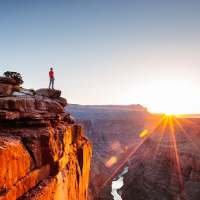The moody strains of a lone guitar waft to the beach from the wraparound verandah of Varadero’s historical museum. A dozen Cubans have gathered there to celebrate the country’s poet laureate, Nicolás Guillén; reading his work aloud and dancing the habanera. Two Canadians amble by and wave. The Cubans smile and motion to them to come over. Soon, Cubans and Canadians are bonding over hand-rolled cigars, shots of dark rum and poignant poetry.
That sunny afternoon embodies the spirit of the real Cuba—Auténtica Cuba—where guests are treated like family. Where culture, creativity, and history blend seamlessly into everyday life while surf rolls softly onto white- sand beaches. Visitors will easily encounter this warm cuban spirit wherever they go—be it lavish resorts, lush mountains or serene beaches.
Seashores and Seashells
Varadero beach remains the country’s most famous vacation spot, having since the early 20th century been a holiday playground for the international set, from robber barons and gangsters to glamorous movie stars and powerful politicians. Only 135 km from Old Havana—a splendid UNEScO World Heritage Site—Varadero bustles with award- winning resorts, a championship golf course, nature-based attractions, and historical sites such as the elegant Dupont mansion and Al Capone’s stone beach villa.
For those seeking a little more serenity, both the Atlantic and Caribbean sides of the country are teeming with alluring island hideaways. The captivating keys (Cayos) strung along Cuba’s atlantic coast about 450 km from Varadero were first claimed by Ernest Hemingway, who used them as settings for his novels Islands in the Stream and The Old Man and the Sea. Cayo Coco, Cayo Santa Maria and Cayo Guillermo, are known for their long, sun-blasted beaches ideal for walking, shell-collecting, or lounging under the palms. The beautiful blue waters attract divers and snorkelers, while rural surroundings offer a glimpse of a simpler life and slower pace.
Off Cuba’s southern coast in the Caribbean Sea you can dive, swim, sail, fish, and sunbathe in laid-back spots like Cayo Largo, Isla de la Juventud, and Jardines de la Reina. Adventuresome visitors can investigate native caves and historical prisons, go birdwatching or visit with the locals in bucolic fishing villages.
Culture and Classics
Contributing to Cuba’s vivid history and culture over the centuries were Spain and Africa, along with other European and Caribbean countries. The Americans, too, left their legacies—the most famous of which are those classic chevys, caddies and Buicks that Cubans have kept running for more than half a century.
Throughout the country, ancient architecture widely recognized by UNEScO will satisfy even the most demanding and sophisticated history buffs. From the 3,000 year old colonial-style buildings in Old Havana’s harbour area, to the sidewalk cafés, restaurants and famous watering holes; there is no shortage of places to mingle. If you're a foodie, you will be pleased to learn that chefs can be as imaginative as any local artists.
In the “other capital,” Santiago de Cuba’s San pedro de la Roca castle, built into a towering cliff overlooking the sea, is an imposing stone fortress that protected the city from invaders. framed by the foothills of the Sierra Maestra Mountains, headquarters of Fidel Castro’s revolution, Santiago de Cuba was named “Heroic city of the Revolution” on January 1, 1959 when Castro announced his victory there.
Today, the city is an ideal home base for further exploring history and nature. for example, it is within an easy 18-km drive to the legendary Basilica del Cobre, home to Cuba’s protector, a black Madonna. also at the Basilica is Ernest Hemingway’s Nobel prize in literature, which he donated to the Cuban people.
One of the country’s most important gifts to the world is its music. Rooted in Spain and Africa, Cuban music has contributed internationally not only to the development of jazz and salsa, but also to Argentinian tango, West african Afrobeat, Ghanaian highlife, and Spanish Nuevo Flamenco.
Historical sites are ideal settings for festivals and cultural events. for example, in the winter months, Old Havana presents the annual festival of New latin american cinema, International Jazz festival, International cigar festival, and National Theatre festival. In May, Santiago de Cuba hosts the International Son festival and every July rocks to the country’s largest carnival. But each month of the year sees an array of events, cultural celebrations and entertainment that adds an exotic Cuban touch to any vacation.
Nature and Nurture
Many of Cuba’s natural endowments are carefully protected to preserve the country’s unmatched biological diversity. Visitors can get a good sense of this in various areas around the country, including national parks such as alejandro de Humboldt—a UNEScO World Heritage site straddling the provinces of Holguín and Guantánamo. In the agricultural Viñales Valley, which produces some of the world’s finest tobacco, you’ll see not only spectacular scenery, but also rural traditions of bygone days. You can explore an Indian cave and soak in the warm mineral springs of San Diego de los Baños. and about 72 km from Havana, you can tour the Rosario Mountains on horseback to see a 22-metre waterfall and orchid garden. As the largest and most diverse caribbean island, Cuba clearly has more to offer than what initially meets the eye. Behind the scenes, its people work diligently to raise the tourism experience beyond the ordinary. at the same time, the country’s natural wonders continue to amaze, soothe, and refresh body, mind and spirit. and Christopher Columbus’s first impression of Cuba in 1492 as “the most beautiful land that human eyes have ever seen” still holds true today.
Size Matters
Cuba is the largest and most diverse caribbean island with 11.2 million inhabitants and more than two million visitors annually— nearly half of which are Canadians. almost as large as florida and only 145 km off the florida Keys, Cuba averages 330 days of sunshine a year. It has 300 beaches, nine UNEScO World Heritage Sites, five centuries of recorded history and unmatched biological diversity. This means that you’ll never run out of things to do, see, taste, and feel—and it helps explain why Canadians return time and again.
Getting there
Cuba is closer than you think: direct flights from major cities across Canada from coast to coast into Varadero, Havana, Holguin, Cayo Coco, Santa Clara, Cienfuegos, Cayo largo, Camaguey, Manzanillo and Santiago de Cuba. Once there, you can sightsee with organized tours or on your own by driving yourself in a rented car or hiring a taxi. You can even rent a classic car for a special event.
Book a trip to Cuba online or stop in to one of our Canada Flight Centre stores near you.










